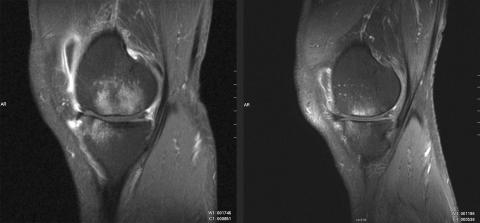Increasing evidence indicates that tumour necrosis factor (TNF) has an important role not only in inflammatory arthritis but also in degenerative joint disease.1,2,3 TNF controls the homoeostasis of matrix synthesis and matrix degeneration in articular cartilage in concert with other cytokines, such as interleukin 1 (IL1), transforming growth factor β, or insulin‐like growth factor 1. Overproduction of TNF and IL1 skews the balance towards matrix degradation, at least in part by virtue of induction of nitric oxide synthesis and subsequent metalloproteinase production. In osteoarthritis (OA), increased TNF production by activated synoviocytes and articular chondrocytes together with increased p55 TNF receptor expression on chondrocytes imply the contribution of TNF mediated matrix degradation to disease pathogenesis.1,4,5 As inhibition of TNF has been shown to suppress nitric oxide production in human cartilage,6 the hypothesis can be formulated that anti‐TNF therapy might be a promising strategy for the treatment of OA.7,8,9
A common clinical feature of OA is bone marrow oedema, which can be detected and quantified by magnetic resonance imaging (MRI). Prevalence and size of bone marrow oedema are related to the degree of cartilage damage10 and to some extent to the severity of pain perceived by the patient.11,12
Here, we report the case of a 68 year old male patient with bilateral OA of the knees. Shortly after the start of symptoms in May 2005, he received high doses of non‐steroidal anti‐inflammatory drugs, without major clinical benefit. Pain increased with time and not only impaired daily activities but also severely disturbed the patient at night. MRI imaging in August 2005 showed severe damage of the articular cartilage in both knees, associated with substantial bone marrow oedema. Additionally, there were signs of arthritic activation with a small synovial effusion and marked synovitis (fig 1).
Figure 1 Contrast enhanced T1 weighted MRI scan of the patient's right knee before (left) and 6 months after initiation of adalimumab therapy (right).
Self medication by the patient—a professor of medicine and specialist in rheumatology—with steroid doses of up to 50 mg/day—led to a prompt relief of symptoms; however, these immediately recurred when the drug was stopped. Given the potential role of TNF in OA, an experimental treatment with the fully human TNF antibody, adalimumab, was started. The patient was treated with the equivalent dose of the antibody recommended for the treatment of rheumatoid arthritis (40 mg subcutaneously every other week). After the second dose, nocturnal pain in the patient's knees completely resolved. Walking, which had been fairly impossible at the beginning of the treatment, was now feasible up to a distance of 1000 m, with only marginal pain. Subsequently, dosing of the TNF inhibitor was adapted to the patient's needs, resulting in treatment intervals of 3–6 weeks. With this treatment regimen and addition of a low dose COX 2‐inhibitor, the patient is now almost free of symptoms. Figure 1 shows an MRI analysis of the patient's right knee before and 6 months after the start of adalimumab therapy. Synovial effusion and synovitis are visibly decreased, while bone marrow oedema has nearly vanished.
This is the first report of a successful treatment of debilitating pain resulting from severe OA with a monoclonal antibody to TNF. The value of anti‐TNF therapy as an option in severe OA needs to be established in larger controlled trials.
Acknowledgments
We thank Professor Dr Joachim R Kalden for his cooperation and dedicate this article in his honour.
References
- 1.Westacott C I, Sharif M. Cytokines in osteoarthritis: mediators or markers of joint destruction? Semin Arthritis Rheum 199625254–272. [DOI] [PubMed] [Google Scholar]
- 2.Kammermann J R, Kincaid S A, Rumph P F, Baird D K, Visco D M. Tumor necrosis factor‐alpha (TNF‐alpha) in canine osteoarthritis: immunolocalization of TNF‐alpha, stromelysin and TNF receptors in canine osteoarthritic cartilage. Osteoarthritis Cartilage 1996423–34. [DOI] [PubMed] [Google Scholar]
- 3.Pelletier J P, Roughley P J, DiBattista J A, McCollum R, Martel‐Pelletier J. Are cytokines involved in osteoarthritic pathophysiology? Semin Arthritis Rheum 199120(suppl 2)12–25. [DOI] [PubMed] [Google Scholar]
- 4.Fernandes J C, Martel‐Pelletier J, Pelletier J P. The role of cytokines in osteoarthritis pathophysiology. Biorheology 200239237–246. [PubMed] [Google Scholar]
- 5.Martel‐Pelletier J, Alaaeddine N, Pelletier J P. Cytokines and their role in the pathophysiology of osteoarthritis. Front Biosci 19994D694–D703. [DOI] [PubMed] [Google Scholar]
- 6.Vuolteenaho K, Moilanen T, Hamalainen M, Moilanen E. Effects of TNFalpha‐antagonists on nitric oxide production in human cartilage. Osteoarthritis Cartilage 200210327–332. [DOI] [PubMed] [Google Scholar]
- 7.Chikanza I, Fernandes L. Novel strategies for the treatment of osteoarthritis. Expert Opin Investig Drugs 200091499–1510. [DOI] [PubMed] [Google Scholar]
- 8.Goldring M B. Anticytokine therapy for osteoarthritis. Expert Opin Biol Ther 20011817–829. [DOI] [PubMed] [Google Scholar]
- 9.Malemud C J, Islam N, Haqqi T M. Pathophysiological mechanisms in osteoarthritis lead to novel therapeutic strategies. Cells Tissues Organs 200317434–48. [DOI] [PubMed] [Google Scholar]
- 10.Kijowski R, Stanton P, Fine J, De Smet A. Subchondral bone marrow edema in patients with degeneration of the articular cartilage of the knee joint. Radiology 19 January 2006 [Epub ahead of print] [DOI] [PubMed]
- 11.Bollet A J. Edema of the bone marrow can cause pain in osteoarthritis and other diseases of bone and joints. Ann Intern Med 2001134591–593. [DOI] [PubMed] [Google Scholar]
- 12.Hayes C W, Jamadar D A, Welch G W, Jannausch M L, Lachance L L, Capul D C.et al Osteoarthritis of the knee: comparison of MR imaging findings with radiographic severity measurements and pain in middle‐aged women. Radiology 2005237998–1007. [DOI] [PubMed] [Google Scholar]



